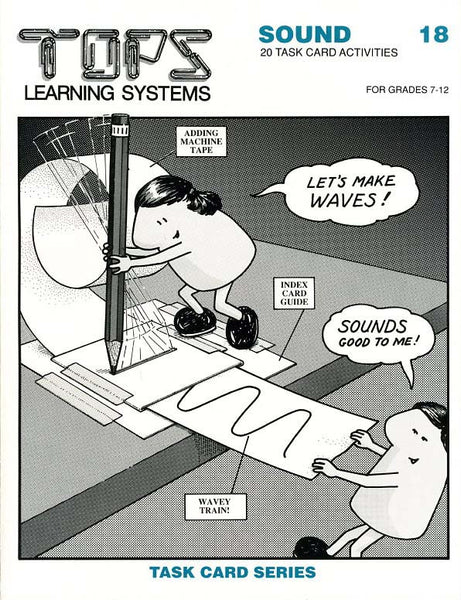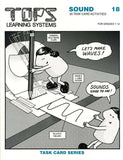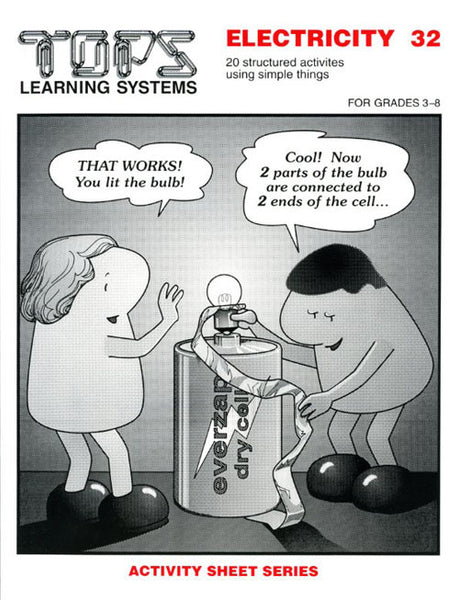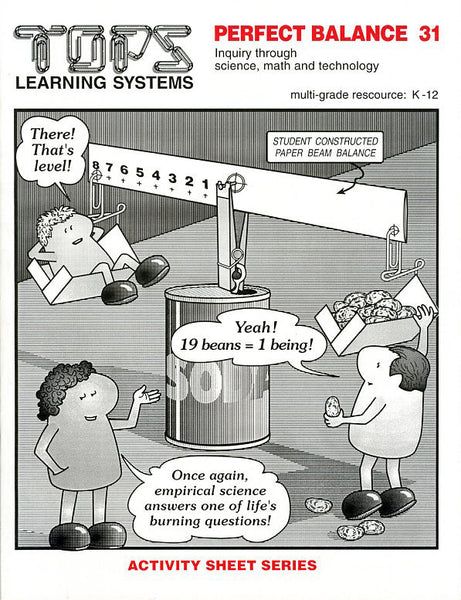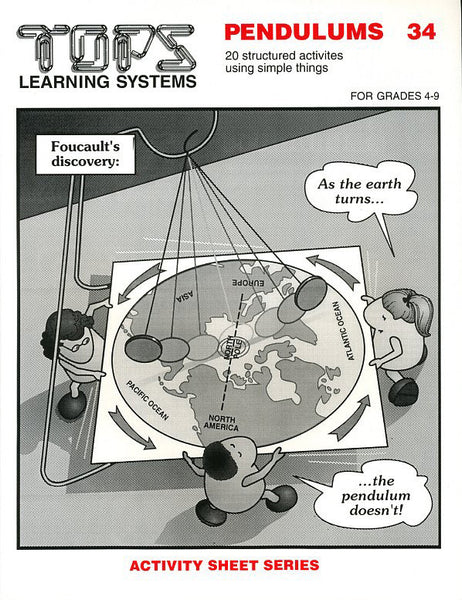#18 Sound (grades 7-12)
Regular price $22.95
Soft-bound, 56 page book, 20 reproducible task cards, full teaching notes.
Generate wave trains across greased glass with a tuning fork. Study amplitude, wavelength, and frequency. Discover relationships between intensity and amplitude, pitch and frequency. Generate longitudinal and transverse waves with a cleverly cut index card! Experiment with resonance and beats. Build a musical instrument.
More Information – click any of the tabs below to learn more about this title
Click here for a complete list of materials and convenient shopping.
Key: (1st/2nd/3rd) denote needed quantities: (1st) enough for 1 student doing all activities; (2nd) enough for 30 students working in self-paced pairs; (3rd) enough for 30 students working in pairs on the same lesson. Starred* items may be purchased below.
* 1/5/10: lower tuning forks stamped with frequency* 1/5/10: higher tuning forks stamped with frequency
1/10/10: drinking glasses or beakers
* 4/20/40: bobby pins
4/40/40: medium sized cans
2/10/20: soda bottles or equivalent
1/10/10: scissors
4/40/40: 4x6 index cards
* 1/2/2: rolls adding machine tape
* 2/20/20: straight pins
* 1/2/2: rolls masking tape
* 3/15/30: clothespins
* 3/30/30: rubber bands
1/1/1: jar petroleum jelly
1/10/10: panes of glass, approximately 10 x 10 cm
1/20/50: pennies
* 1/1/1: spool of thread
1/10/10: meter sticks or metric rulers
1/1/1: wall clock with second-hand sweep (or wrist watches)
1/10/10: hand calculators
1/3/10: Ping-Pong balls (marbles)
1/6/10: dinner forks
1/1/1: roll of string
1/5/10: hammer and nails (optional)
* 7/70/70: straight plastic straws
* 0.2/1/2: cups of clay
* 2/15/20: paper clips
1/1/1: bottle cooking oil (baby oil)
* 1/1/1: roll of thin bare wire, about 22 gauge
1/1/1: wire cutters (optional)
1/4/10: tuna cans or equivalent
1/4/10: old phonograph records
1/1/1: paper punch tool
1/1/1: pairs of wood blocks (or a spoon and pan)
- Lesson 1: To recognize that sound is produced by vibrating objects.
- Lesson 2: To build a device that generates waves. To produce waves of different lengths.
- Lesson 3: To record the vibrating end of a bobby pin as a wave train by streaking it across greased glass.
- Lesson 4: To measure frequency by counting cycles over measured units of time. To express frequency in cycles per second or Hertz units.
- Lesson 5: To calculate the speed of a wave train, knowing its frequency.
- Lesson 6: To determine the speed that a tuning fork sweeps across creased glass, knowing the frequency of the wave train it leaves behind.
- Lesson 7: To understand that sound intensity increases with the amplitude of the vibrating source.
- Lesson 8: To appreciate that the pitch of a sound increases with the frequency of its vibrating source. To experimentally determine the ratio of frequencies for 2 tuning forks of different pitch.
- Lesson 9: To identify mediums of sound. To recognize that sound is transmitted as its medium vibrates.
- Lesson 10: To study differences between transverse and longitudinal waves.
- Lesson 11: To understand how longitudinal waves transmit sound energy.
- Lesson 12: To examine 3 ways to change the pitch of a vibrating string.
- Lesson 13: To account for changes in pitch as water is added to a bottle. To identify 2 distinct sources of sound.
- Lesson 14: To observe how objects with the same natural frequency resonate as one is sounded in the presence of the other.
- Lesson 15: To hear beats between interacting tones with slightly different pitches. To understand why the beat frequency decreases as tones converge to the same pitch.
- Lesson 16: To investigate the mathematical relationship between vibrating wires that sound octaves apart.
- Lesson 17: To confirm the octave rule for long vibrating wire. To explore the lower threshold of sound.
- Lesson 18: To build a working model of a phonograph. To understand how it works.
- Lesson 19: To build a reed instrument. To experiment with variables that change the pitch.
- Lesson 20: To experimentally calculate the speed of sound in air.
We encourage improvisation - it's one of the main goals of our hands-on approach! You and your students might invent a simpler, sturdier or more accurate system; might ask a better question; might design a better extension. Hooray for ingenuity! When this occurs, we'd love to hear about it and share it with other educators.
National Science Education Standards (NRC 1996)
Teachers of science...
A: ...plan an inquiry-based science program. (p. 30)
B: ...guide and facilitate learning. (p. 32)
C: ...engage in ongoing assessment of their teaching and of student learning. (p. 37)
D: ...design and manage learning environments that provide students with the time, space, and resources needed for learning science. (p. 43)
• Represent a central event or phenomenon in the natural world.
• Represent a central scientific idea and organizing principle.
• Have rich explanatory power.
• Guide fruitful investigations.
• Apply to situations and contexts common to everyday experiences.
• Can be linked to meaningful learning experiences.
• Are developmentally appropriate for students at the grade level specified.
Core Concepts/Processes: Sound is transmitted by the mechanical vibration of matter.
Core Inquiries: Generate sound vibrations • Correlate amplitude with intensity • Correlate frequency with pitch
Core Content: Wave trains • Wave lengths • Wave speed • Transverse waves • Longitudinal waves • Resonance • Beats
TEACHING Standards
These 20 Task Cards promote excellence in science teaching by these NSES criteria:Teachers of science...
A: ...plan an inquiry-based science program. (p. 30)
B: ...guide and facilitate learning. (p. 32)
C: ...engage in ongoing assessment of their teaching and of student learning. (p. 37)
D: ...design and manage learning environments that provide students with the time, space, and resources needed for learning science. (p. 43)
CONTENT Standards
These 20 Task Cards contain fundamental content as defined by these NSES guidelines (p. 109).• Represent a central event or phenomenon in the natural world.
• Represent a central scientific idea and organizing principle.
• Have rich explanatory power.
• Guide fruitful investigations.
• Apply to situations and contexts common to everyday experiences.
• Can be linked to meaningful learning experiences.
• Are developmentally appropriate for students at the grade level specified.
Unifying Concepts and Processes
NSES Framework: Systems, order, and organization • Evidence, models and explanation • Constancy, change, and measurement • Form and functionCore Concepts/Processes: Sound is transmitted by the mechanical vibration of matter.
Science as Inquiry (content standard A)
NSES Framework: Identify questions that can be answered through scientific investigations. • Design and conduct a scientific investigation. • Use appropriate tools and techniques to gather, analyze, and interpret data. • Develop descriptions, explanations, predictions, and models using evidence. • Think critically and logically to connect evidence and explanations. • Communicate scientific procedures and explanations. • Use mathematics in all aspects of scientific inquiry.Core Inquiries: Generate sound vibrations • Correlate amplitude with intensity • Correlate frequency with pitch
Physical Science (content standard B)
NSES Framework: Position and motion of objects • Structure and properties of matter • Interactions of energy and matterCore Content: Wave trains • Wave lengths • Wave speed • Transverse waves • Longitudinal waves • Resonance • Beats

